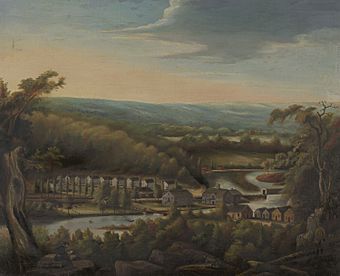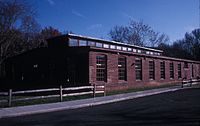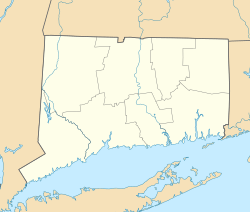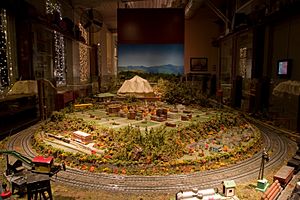Eli Whitney Museum facts for kids
Quick facts for kids |
|
|
Eli Whitney Gun Factory
|
|

1827 painting of the Gun Factory by William Giles Munson
|
|
| Location | 915-940 Whitney Ave., Hamden, Connecticut |
|---|---|
| Area | 9.9 acres (4.0 ha) |
| Built | 1798 |
| NRHP reference No. | 74002049 |
| Added to NRHP | August 13, 1974 |
 |
|
| Established | 1979 |
|---|---|
| Location | Hamden, Connecticut |
The Eli Whitney Museum in Hamden, Connecticut, is a cool place for students, teachers, and families to learn by doing. It's like a workshop where you can experiment and build things. The museum is built on part of the old Eli Whitney Gun Factory. This factory was started by the famous inventor Eli Whitney way back in 1798.
The museum helps people understand how design and invention work. It has lots of hands-on projects and exhibits. You can learn about Eli Whitney himself and also about A. C. Gilbert, who invented the Erector Set toys.
The Factory's Story
The museum sits on land that Eli Whitney bought on September 17, 1798. He wanted to build a factory there to make muskets, which are a type of old gun. The factory used water power from the Mill River to run its machines. It made muskets for the United States government.
In June 1798, Whitney signed a contract to make 10,000 muskets. He promised to deliver them in 28 months. The cost was $134,000.00. But it actually took him ten years to finish the order! When he signed the contract, Whitney didn't even have a factory, workers, or experience making guns.
He wrote a letter to his friend Oliver Wolcott, who was the Secretary of the Treasury. Whitney said he believed that machines powered by water would make gun manufacturing much easier. He thought machines could help with forging, rolling, boring, grinding, and polishing.
Whitney's factory was a very important part of the early American Industrial Revolution. It used machines powered by water. It was also one of the first places to use interchangeable parts. This meant that if a part broke, you could easily replace it with another identical part. This was a big deal for manufacturing.
The area around the museum used to be called Whitneyville. This was a village built along the Mill River for the factory workers. A painter named William Giles Munson made the Armory famous. He sketched it in 1826, a year after Whitney died. He then created at least three paintings from those sketches.
The Armory made firearms for 90 years. But in the late 1880s, it started losing to the Winchester Repeating Arms Company. Eli Whitney Jr., the inventor's son, sold the factory to Winchester in 1888. Winchester then closed it down.
Today, the museum grounds are on both sides of Whitney Avenue and cross the Mill River. You can still see some old buildings from Whitneyville. These include the old barn, a stone coal shed, and a boarding house. There's also a rebuilt Ithiel Town lattice truss covered bridge. This bridge is on the original supports of one of the two bridges that served the Eli Whitney Armory.
The museum itself is in a brick factory building built in 1890. It's located between Whitney Avenue and the Mill River. The barn and boarding house are west of Whitney Avenue and are used by other groups.
What to See and Do at the Museum
The Eli Whitney Museum has exhibits about Eli Whitney and his most famous invention, the cotton gin. Other exhibits tell the story of the historic factory site. You can also learn about A. C. Gilbert, the inventor and toy maker. He is best known for creating the erector set.
The museum is a hands-on learning place for design. It specializes in building projects for kids. These projects combine science and invention. The museum is next to the dam that Eli Whitney first built to power his factory. This dam was later made taller by Eli Whitney Blake for even more power.
The museum also has water tables with canal locks, which are fun to play with. It's next to a water reservoir and hiking trails too. Besides regular visiting hours, the museum offers summer and holiday programs. You can even have birthday parties there!
The museum also hosts the annual Leonardo Challenge. This is a fun event where artists and designers from the New Haven, Connecticut area create new inventions. They use everyday objects in creative ways. Their amazing creations are then shown in an exhibition.
Apprenticeship Program
The museum has special education programs that last a day or a week. It also has a longer-term Apprenticeship Program. About 60 apprentices work there at a time. They get paid for their hands-on experience.
Apprentices are usually between 13 and 18 years old. They typically work 200 hours during the school year and 400 hours in the summer. They learn important skills like design, how to build things, and how to teach. They use these skills to create and teach exhibitions and projects.
Some famous people who were once apprentices include Jennifer Oxley, who creates children's TV shows. Another is Emily Oster, an economist. And Joshua Revkin, a champion sailor, also started here.
See also




